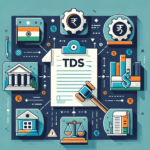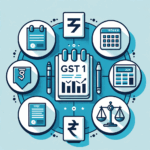Lower TDS Deduction Certificate (Form 13): Who Should Apply and How?
Is a significant portion of your income getting locked up as TDS every month? Waiting for a tax refund at the end of the year can seriously impact your cash flow, leaving you with less money in hand for your monthly expenses, investments, or business operations. But what if there was a way to legally reduce this deduction from the start? The solution lies in a powerful provision within the Income Tax Act: the Lower TDS Deduction Certificate. This certificate, obtained by filing Form 13, allows you to have tax deducted at a lower rate, or even at a nil rate, directly addressing the problem of excess tax deduction at its source. This comprehensive guide will walk you through exactly what Form 13 is, who is eligible to apply, its significant benefits for your financial health, and the step-by-step process to secure your certificate and improve your monthly take-home pay or business revenue.
What Exactly is a Lower TDS Deduction Certificate (Form 13)?
A Lower TDS Deduction Certificate is an official document issued by an Assessing Officer (AO) from the Income Tax Department. It is procured by submitting an application through Form 13, a process governed by Section 197 of the Income Tax Act, 1961. The primary function of this certificate is to provide formal authorization to a specific payer (referred to as the deductor) to deduct Tax at Source (TDS) from your payments at a rate lower than the standard prescribed rate. In cases where your total tax liability for the year is projected to be zero, the certificate can even permit a ‘Nil’ deduction. This mechanism is designed to prevent financial hardship for taxpayers by ensuring that the tax deducted is more closely aligned with their actual, final tax liability for the financial year. It’s crucial to understand that this certificate is highly specific; it is issued for a particular PAN, applies only to specified deductors mentioned in the application, and is valid only for the financial year in which it is issued. You cannot use the same certificate for a new client or in the next financial year; a fresh application is required each time your circumstances change or a new financial year begins.
Who Should Apply for a Lower TDS Deduction Certificate in India?
The provision for a lower TDS certificate is not limited to a single category of taxpayer. It is a valuable tool for anyone who consistently finds that their TDS deductions are significantly higher than their actual tax liability, leading to large, recurring tax refunds. The key criterion is a mismatch between the tax being deducted and the tax that is genuinely due. Understanding if you fall into this category is the first step toward unlocking better cash flow. Let’s explore the common scenarios for different types of taxpayers to determine who should apply for a TDS certificate in India.
For Salaried Individuals
For salaried employees, the monthly TDS deduction by an employer is often a standard calculation based on salary and declared investments. However, this system isn’t always perfect and can lead to excess deductions in specific situations.
- Scenario 1: High Tax-Saving Investments and Deductions: You are an ideal candidate if you have substantial deductions that significantly lower your taxable income. This includes, but is not limited to, high interest payments on a home loan (under Section 24), fully utilizing the Section 80C limit (₹1.5 lakh), paying significant health insurance premiums for self and parents (under Section 80D), contributing to the National Pension System (NPS), or having education loan interest payments (under Section 80E). When these combined deductions are not fully accounted for by your employer’s TDS calculation, a lower TDS certificate can rectify the monthly deduction rate.
- Scenario 2: Consistently Large Refunds: Take a look at your tax returns for the past few years. If you have been consistently receiving a large tax refund each year, it is a clear indicator that you are having excess tax deducted from your salary month after month. Essentially, you are giving an interest-free loan to the government, which you only get back after filing your return. Applying for Form 13 breaks this cycle. For a detailed walkthrough, our Step-by-Step Guide to Filing Income Tax Returns for Salaried Individuals in India can be very helpful.
- Benefit Highlight: The primary benefit here is immediately tangible. The TDS certificate benefits for salaried individuals translate directly to an increased take-home salary each month. This extra cash can be used for investments, managing expenses, or achieving financial goals faster, rather than being locked up until the refund is processed.
For Small Business Owners, Freelancers, and Professionals
For non-salaried individuals, TDS is often deducted at a flat rate on the gross invoice value, which can severely impact business finances.
- Scenario 1: Income Below Taxable Limit: A common situation for new freelancers, consultants, or contractors is that their total estimated annual income is well below the basic exemption limit (e.g., ₹2.5 lakh or ₹3 lakh depending on the regime and age). However, their clients are legally obligated to deduct TDS (for instance, at 10% under Section 194J for professional services or 1% under 194C for contracts) on every payment. In this case, applying for a Nil Deduction Certificate is essential to receive the full payment without any tax being cut. Our guide on Filing Tax Returns for Freelancers and Consultants provides more detailed information on managing your tax obligations.
- Scenario 2: High Operating Expenses: Many businesses, especially in the service or contracting sectors, operate on high revenue but have significant operating expenses, resulting in a low net profit margin. For example, a contractor might receive a payment of ₹5 lakh, but their expenses for materials and labor could be ₹4.5 lakh, leaving a profit of only ₹50,000. If TDS at 1% (₹5,000) is deducted on the gross amount, it represents a significant 10% of their actual profit. This can block crucial working capital needed for day-to-day operations. A lower TDS certificate ensures the deduction is more proportionate to the actual profit.
- Benefit Highlight: The most significant advantage for this group is the massive improvement in business cash flow. It reduces the dependency on tax refunds to manage operational costs, pay suppliers, or invest in business growth. It ensures that money earned is available to the business when it is needed most.
For NRIs with Income from India
Non-Resident Indians (NRIs) who earn income from sources in India, such as rental income from property, interest on bank deposits, or capital gains, are often subject to TDS at the highest applicable rates. This is a precautionary measure by the tax department. However, if an NRI’s total taxable income in India is low, or if they are eligible for benefits under a Double Taxation Avoidance Agreement (DTAA) between India and their country of residence, the tax deducted can be far more than their actual liability. By applying for Form 13, NRIs can get a certificate that directs the payer (e.g., the tenant or the bank) to deduct tax at a much lower or even a nil rate, ensuring they receive their rightful income without unnecessary blockage of funds. For a deeper dive, you can read our guide on Understanding the TDS Rules for NRIs on Rental Income and Property Sales.
The Step-by-Step Guide: How to Apply for Form 13 in India
The lower TDS deduction certificate process in India has been streamlined and is now entirely online, making it more accessible for taxpayers. Following the correct procedure and submitting accurate information is key to getting your application approved promptly. This guide will detail how to apply for Form 13 in India through the official government portal.
Step 1: Gather Required Documents & Information
Before you begin the TDS deduction certificate application India process, it’s crucial to have all the necessary information and documents ready. Proper preparation will make the online filing smooth and minimize the chances of queries from the Assessing Officer.
- PAN Card: Your Permanent Account Number is the primary identifier.
- TAN of Deductors: You must have the Tax Deduction and Collection Account Number (TAN) of every client, employer, or payer who will be deducting your TDS. Ensure this is correct, as the certificate is issued specifically for each deductor.
- Estimated Income Calculation: A detailed projection of your total income for the current financial year. For salaried individuals, this includes salary, bonuses, and any other income.
- Projected Profit and Loss Account: For businesses and professionals, a realistic projection of revenue and expenses for the current financial year is required to justify the lower profit margin.
- ITR Acknowledgments: Copies of your Income Tax Return (ITR) acknowledgments for the last 3-4 assessment years. This provides the officer with a history of your income and tax payments.
- Details of Outstanding Demands: You must provide information on any pending tax demands against your PAN on the income tax portal.
- Supporting Documents: Depending on your case, you may need to upload copies of contracts or agreements with your clients, rental agreements, or investment proofs.
Step 2: The Online Application Process on the TRACES Portal
The entire application is submitted online through the TRACES (TDS Reconciliation Analysis and Correction Enabling System) portal.
- Visit the Portal: Go to the official TRACES website: https://www.tdscpc.gov.in/app/login.xhtml.
- Login/Register: If you are a new user, you must register on the portal as a “Taxpayer” using your PAN card details. If you are already registered, log in with your User ID (which is your PAN) and password.
- Navigate to Form 13: Once logged in, go to the ‘Statements / Forms’ tab on the dashboard. From the dropdown menu, select ‘Request for Form 13’.
- Fill the Application: The online form will prompt you to fill in several details accurately. This includes your basic personal information, the financial year for which the certificate is needed, the details of your deductors (including their TAN), the estimated total income for the year, and importantly, the specific lower rate of TDS you are requesting.
- Upload Documents: You will be prompted to upload the supporting documents that you gathered in Step 1. Ensure these are clear, scanned copies in the prescribed format and size.
- Submit and Verify: After carefully reviewing all the entered information, you need to submit the form. The submission must be verified using either a Digital Signature Certificate (DSC) or through E-Verification, which is typically done via an Aadhaar-based One-Time Password (OTP). Once submitted, an acknowledgement number will be generated. Keep this number safe for tracking the status of your application.
Step 3: Assessing Officer’s Review and Approval
Your work isn’t over once you hit ‘submit’. The application now enters the review stage.
- Assignment to AO: Your submitted application is automatically forwarded to the jurisdictional Assessing Officer (AO) responsible for your PAN.
- Review and Scrutiny: The AO will meticulously review your application, the estimated income computation, and all the supporting documents you have uploaded. Their goal is to verify that your claim for a lower deduction is justified based on your projected tax liability.
- Responding to Queries: It is common for the AO to raise queries or ask for additional documents or clarification. These queries will be raised online through the portal. You must be diligent in checking the status of your application and responding to any queries promptly. Delays in your response can lead to delays in approval or even rejection of your application.
- Approval and Issuance: Once the AO is fully satisfied with your justification and documentation, they will approve the application. The Lower TDS Deduction Certificate will then be generated and made available for download on the TRACES portal.
Key Benefits of Obtaining the Certificate
Securing a Form 13 certificate offers several powerful advantages that directly impact your financial well-being. It is a proactive financial management strategy rather than a reactive measure taken at the end of the year.
- Improved Cash Flow: This is the most significant benefit. You receive more money in your hand every month or with every payment. For a salaried person, it means a higher net salary. For a business, it means more working capital to run and grow the business without constraints.
- Eliminates Refund Delays: The Indian tax refund process, while improving, can still involve delays. By preventing excess deduction in the first place, you eliminate the need to wait for a refund, freeing you from the uncertainty and follow-up associated with it.
- Better Financial Management: A predictable and higher monthly income or revenue stream allows for much better financial planning. You can budget more effectively, meet your financial obligations with ease, and allocate funds towards investments or savings goals systematically.
- Legally Sanctioned: This is not a tax loophole or an evasion tactic. The Lower TDS Deduction Certificate is a facility provided under the Income Tax Act itself. It is a completely legal and government-approved method to align your tax deductions with your actual tax liability.
Conclusion
In conclusion, a Lower TDS Deduction Certificate is an invaluable financial tool for any individual or business whose TDS deductions are disproportionately high compared to their final tax liability. It is a proactive step that shifts you from the passive position of waiting for a year-end refund to actively managing your cash flow throughout the year. By taking control of your tax deductions, you can free up valuable funds for investments, accelerate business growth, or simply enjoy better financial stability. The process is transparent and online, but it requires careful financial projection and meticulous documentation.
The TDS deduction certificate application India process can seem daunting, especially when it comes to accurately estimating income and justifying the lower rate to the tax authorities. To ensure a smooth, error-free, and successful application, it is always wise to seek expert guidance. Contact TaxRobo’s financial experts today, and let us help you improve your cash flow!
FAQs Section
Q1. For how long is a Lower TDS Deduction Certificate valid?
A: The certificate is generally valid only for the specific financial year for which it is issued. It is linked to your income projections for that particular year. You must reapply for a new certificate for the next financial year if your situation remains the same.
Q2. Can I apply for a ‘Nil’ TDS deduction?
A: Yes. If your estimated total income for the financial year is below the basic exemption limit, resulting in zero tax liability, you can apply for a Nil Deduction Certificate. The AO will grant this if your calculations and supporting documents convincingly prove that no tax will be due from you for that year.
Q3. What should I do after my Form 13 application is approved?
A: Once approved, you must download the certificate from the TRACES portal. Immediately provide a copy of this certificate to each of your deductors (for example, your employer’s HR/finance department or your client’s accounts team). They are required to verify the certificate on the TRACES portal and will then apply the lower rate specified in the certificate for all future payments made to you during that financial year.
Q4. My application was rejected. What are my options?
A: If your application is rejected, the Assessing Officer is required to provide the reasons for the rejection. You should first analyze these reasons. If it’s due to a correctable error or missing information, you can rectify the issues and file a fresh application. If you disagree with the AO’s reasoning, you have the right to file an appeal against the decision with the Commissioner of Income Tax (Appeals). In the meantime, your deductor will have to continue deducting TDS at the standard applicable rates until a valid certificate is provided.



